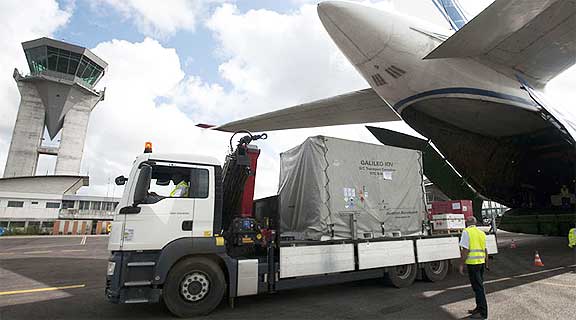...from the Spaceport has arrived in French Guiana, stepping up the activity involving this mission, which is scheduled in the second half of 2012. Delivered by a chartered Antonov An-124 cargo jetliner, the Galileo FM3 (Flight Model #3) spacecraft arrived this week at Félix Eboué International Airport near the capital city of Cayenne and was transferred by road to the Spaceport’s S1B payload preparation building.
The two Galileo satellites to be orbited on the next Soyuz mission will join another pair lofted by Arianespace on this medium-lift launcher’s maiden flight from French Guiana in October 2011. Together, the four spacecraft are to form the minimum coverage required for satellite-based navigation—providing latitude, longitude and altitude data, while also checking ranging accuracy. As a result, these In-Orbit Validation Galileo satellites will enable European industry to validate prototype Galileo-based receivers and services against actual satellite signals, while also allowing performance assessments of Galileo’s ground system that serves to maintain the Galileo system’s precision. The IOV spacecraft are produced in a European industry consortium led by the Astrium division of EADS and Thales Alenia Space.
In addition to the Galileo FM3 spacecraft’s arrival this week, team members from Astrium, Thales Alenia Space and the European Space Agency also have converged on the Spaceport, moving into the offices they will use during the pre-launch preparations of this satellite, along with its “sister” passenger—Galileo FM4, scheduled to arrive in French Guiana during the next few days. The team’s initial activities included attending safety and operational briefings, along with the kickoff of regular planning and progress meetings.
Long-lead preparations also are underway at the Spaceport’s ELS launch site for the upcoming Soyuz mission, which is designated VS03 in Arianespace’s numbering system. The “V” represents “flight” (Vol) in French, while “S” signifies the use of a Soyuz launch vehicle, and its “3” denotes the third Arianespace mission of Soyuz from French Guiana.

The container with Europe’s Galileo FM3 navigation satellite is unloaded from the An-124 cargo jetliner at Félix Eboué International Airport.
Photo courtesy of Arianespace.
Galileo is a program initiative of the European Commission and European Space Agency (ESA) for an independent global satellite navigation system. The complete Galileo system will consist of 30 satellites in orbit. Each platform combines an optimized atomic clock for navigation—accurate to one second in three million years – with a powerful transmitter to broadcast precise navigation data worldwide.
Arianespace has also been selected by the European Commission and ESA to deploy the entire Galileo constellation. This activity began in 2005 and 2008 with the launch of the first two experimental satellites, Giove-A and Giove-B, orbited from Baikonur Cosmodrome in Kazakhstan by Arianespace’s Starsem affiliate; and then continued last October with the maiden Soyuz launch from French Guiana that carried the constellation’s first two operational satellites. Arianespace’s deployment of the remaining spacecraft will continue through 2015, using a mix of both Soyuz and Ariane 5 launch vehicles, underscoring the company’s flexibility in orbiting satellite constellations. The medium-lift Soyuz and heavy-lift Ariane 5 are part of Arianespace’s launcher family that operates side-by-side from the Spaceport, which also includes the light-lift Vega vehicle.

